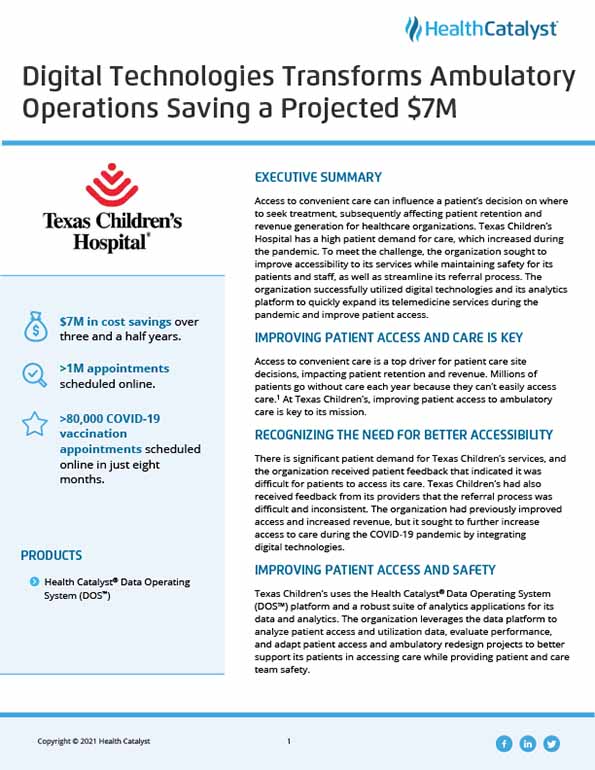Access to convenient care can influence a patient’s decision on where to seek treatment, subsequently affecting patient retention and revenue generation for healthcare organizations. Texas Children’s Hospital has a high patient demand for care, which increased during the pandemic. To meet the challenge, the organization sought to improve accessibility to its services while maintaining safety for its patients and staff, as well as streamline its referral process. The organization successfully utilized digital technologies and its analytics platform to quickly expand its telemedicine services during the pandemic and improve patient access.
Access to convenient care is a top driver for patient care site decisions, impacting patient retention and revenue. Millions of patients go without care each year because they can’t easily access care.1 At Texas Children’s, improving patient access to ambulatory care is key to its mission.
There is significant patient demand for Texas Children’s services, and the organization received patient feedback that indicated it was difficult for patients to access its care. Texas Children’s had also received feedback from its providers that the referral process was difficult and inconsistent. The organization had previously improved access and increased revenue, but it sought to further increase access to care during the COVID-19 pandemic by integrating digital technologies.
Texas Children’s uses the Health Catalyst® Data Operating System (DOS™) platform and a robust suite of analytics applications for its data and analytics. The organization leverages the data platform to analyze patient access and utilization data, evaluate performance, and adapt patient access and ambulatory redesign projects to better support its patients in accessing care while providing patient and care team safety.
In addition, Texas Children’s made use of multiple digital technologies to expand telemedicine rapidly, improve patient access, and increase safety measures during the pandemic. It developed new processes that enabled touch-free care experiences and invested in care-delivery innovation using an agile approach to further advance its patient access and ambulatory redesign projects. Texas Children’s also uses its EMR to support patients in self-scheduling online. Patients receive reminders for their upcoming appointments, complete pre-visit paperwork, check in for their appointments, and self-arrive—all online.
To support its rapid expansion of telemedicine, Texas Children’s implemented a virtual visit support center. The virtual visit support center team includes medical assistants (MAs) and ambulatory service representatives. The virtual support center staff reach out to each patient before their appointment, ensuring they are comfortable and ready. Staff help the patients complete any pre-visit paperwork and verify the child and parent/guardian’s availability for the visit. Virtual visit support staff confirm that the environment the patient is in is appropriate for the visit, make sure the technology is working appropriately, check the patient portal activation, and, if needed, schedule an interpreter.
An MA welcomes each patient to their telehealth visit and “rooms” the patient in their virtual care room. If an interpreter is needed, the MA confirms the interpreter is logged in to the visit. Next, the MA confirms the patient has completed the consent for treatment forms and completes rooming tasks such as recording height and weight measurements, taking a brief history, and soliciting a medication history from the patient. Patients are then ready to successfully complete their telehealth visit with their provider.
Texas Children’s uses the analytics platform to evaluate the impact of workflow changes on patient access, patient satisfaction, and revenue while regularly communicating the impact to stakeholders.
Texas Children’s data-informed patient access and ambulatory redesign projects have improved patient access and ensured the continuation of care during the pandemic while keeping its patients and care teams safe. Texas Children’s has achieved:
We were able to launch telemedicine at Texas Children's when our patients needed it the most. Our data demonstrates we've saved $7M while successfully improving access and increasing patient satisfaction.
- Carrie Rys, MBA, Assistant Vice President, Pediatrics, Texas Children's Hospital
Texas Children’s will continue to use digital technologies to meet changing patient preferences and complement the organization’s compassionate patient care.


